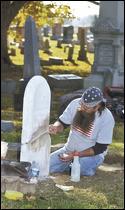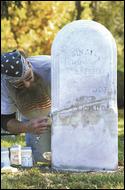
By Emma Bowen Meyer, For The Herald Bulletin
November 22, 2008 08:41 pm
—
MECHANICSBURG — Virtually unreadable are some of the names and dates.
Stones are tipped precariously and others lie in pieces.
The pioneers who founded nearby Mechanicsburg are buried beneath the earth, marked over a century ago with marble.
But there are no records indicating whose body lies in certain plots.
So the board operating the Mechanicsburg Cemetery has taken action to restore the tombstones before irreparable damage is done.
Looking
at the stones that date back to 1848, when the cemetery was
established, passers-by may think it is already too late. Some markers
can only be read by running a finger across the faded words; the poetry
inscribed on some is impossible to decode.
But some have been
restored by John “Walt” Walters, the owner of Graveyard Groomer of
Connersville. Those tombstones are pristine white and look brand new.
“They’ve
got 150 to 160 years of what’s come out of the sky on them – acid rain,
salt. That attaches itself to the algae that’s on there and
deteriorates the stone,” he says. “We’ve probably given them another
100 plus years by giving them a good cleaning like this. We can’t make
them vandal-proof but we can make them respectable again.”
Walters
says that lichen grows on tombstones and fills in the letters. Once he
painstakingly cleans with ammonia and water, 75 percent of them are
again legible.
Because limestone and marble are polishable stones, they become white and shiny with a proper investment of elbow grease.
Around
150 tombstones in the cemetery need to be restored, according to Steve
Cooper, board member of Mechanicsburg Cemetery Association Inc.
Thirty-four were marked for Walters’ attention, but due to financial
constraints, he was only hired for one week.
“We are hoping (the
markers) are in the place where they originally stood,” Cooper says,
mentioning that the earthquake in the spring shifted a lot of the
stones. “We do not have the records for this part of the cemetery.
That’s the reason the board determined that we could not go another
year without some work being started.”
A large, strangely empty
place stands in the center of rows of tombstones. Cooper hopes one day
to probe for markers he suspects have sunk beneath the surface to be
covered by Mother Nature.
Planning to hire Walters on a yearly
basis, restoring as many graves as is affordable, Cooper said he is
excited about being able to read the old markers.
“I would love to
know what some of this poetry says,” he remarks as he strolled by
ornate stones. “And I love the way they used to write ages on the
markers.”
His passion for old cemeteries is shared by Phyllis Boze,
the president of the board. Both admit visiting graveyards on vacations
just to enjoy looking at various tombstones and landscaping.
“This
cemetery has always been known as a beautiful cemetery and relatives
and the community wanted it to continue as a beautiful cemetery,” Boze
says, pointing out that she has ancestors from both sides of her family
buried at this location. “My great-great grandfather has one of the
first plots as you drive in – Riggs.”
“I have family here, both my
grandparents and my great-great grandparents are buried in this
cemetery,” adds Cooper. “Our family came here in 1828. And a lot of
these names I’ve heard all my life from relatives. It truly is a
pioneer cemetery – this part that we are doing the restoration on.”
Walters has been caring for cemeteries for over 12 years. Mowing
cemeteries in his town led him to a new passion. He taught himself
through a great deal of research to restore pioneer tombstones.
“The
same way they cared for statues and other limestone marble buildings, I
started taking that and applying it to gravestone work,” he says.
“There
wasn’t a how-to book and it was hard. But I found a passion for it. I
saw what people were trying to do with really good intentions, but it
was doing more damage than good. Stones would fall back over and break
into more pieces than they were in at first.
“I knew what not to do
from failed attempts. So I started working on proper epoxies and proper
mortars, learned the respect of the graveyard and staying historically
accurate.”
Walters’ studies and workmanship led him to one job
after another, working off referrals from previous clients. He has
worked in six states and 37 Hoosier counties. He received work from a
woman in Germany who found him online. With family in Seymour, she
asked him to restore the tombstones and send before and after photos.
While
attempting to renovate the original tombstones without remaking pieces
from new material, Walters often finds essential elements missing.
“The
common rule of setting is there should always be a base,” he says,
pointing to a tall marker made of several different pieces fitted
together. “A lot of these foundations are missing and that’s why they
are leaning over. I wonder what happened to what they used to sit on.”
In
cases like that, he casts a new base and levels it before resetting the
restored pieces in place. His best guess about the missing foundations
is that someone attempted to repair the tombstones in the past and, for
whatever reason, decided it was best to remove them.
Although he
readily admits he enjoys the problem solving associated with his
craftsmanship, Walters says learning history everywhere he travels is
equally exciting.
“I love it. You learn a lot in an old cemetery,”
Walters adds. “I love it when an older man or woman comes and tells me
stories of the people in the town. It didn’t get this way overnight and
it won’t be repaired overnight, but hopefully I can keep coming back
year after year until it’s finished.”
The cemetery was originally
established by the Methodist Episcopal Church on land deeded by George
and Elizabeth Keesling and William and Mary Alexander. Having grown
from a one-acre beginning, the cemetery now spreads over 15 acres.
“I
know a lot of family history and a lot of local history,” says Cooper
with a smile. “You can take a lot of these names and still find
relatives living in the community.”
Any individual or
organization that would like to contribute funds to help defray the
cost of this work would be welcomed; as a not-for-profit corporation,
any contributions would be tax deductible. To directly contact Walters,
visit www.graveyardgroomer.com.
Copyright © 1999-2008 cnhi, inc.
Photos

John
"Walt" Walters is the "Graveyard Groomer." Walters is restoring
headstones in the Mechanicsburg Cemetery. John "Walt" Walters and his
helper Randy Jones prepare to set the base of one of the headstones
they have repaired in the Mechanicsburg Cemetery.
The Herald Bulletin

John
"Walt" Walters is the "Graveyard Groomer." Walters is restoring
headstones in the Mechanicsburg Cemetery. Randy Jones and John "Walt"
Walters place the top of this headstone back into the base while
working on restoring old markers in the Mechanicsburg Cemetery.
The Herald Bulletin

John "Walt" Walters is the "Graveyard Groomer." Walters is restoring headstones in the Mechanicsburg Cemetery.
The Herald Bulletin

John
"Walt" Walters is the "Graveyard Groomer." Walters is restoring
headstones in the Mechanicsburg Cemetery. Walters is filling in the
crack to smooth out the surface of a headstone that he had bonded
together from two pieces.
The Herald Bulletin